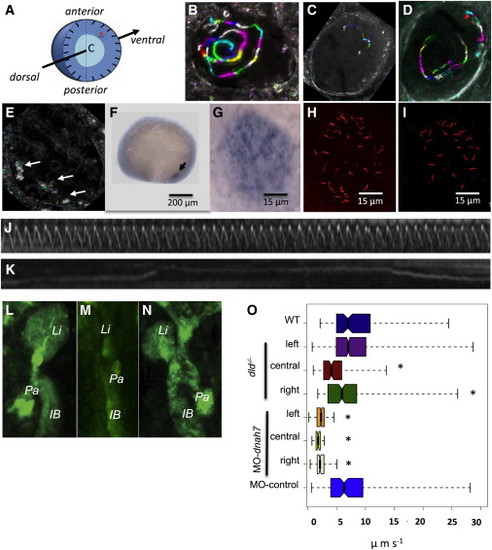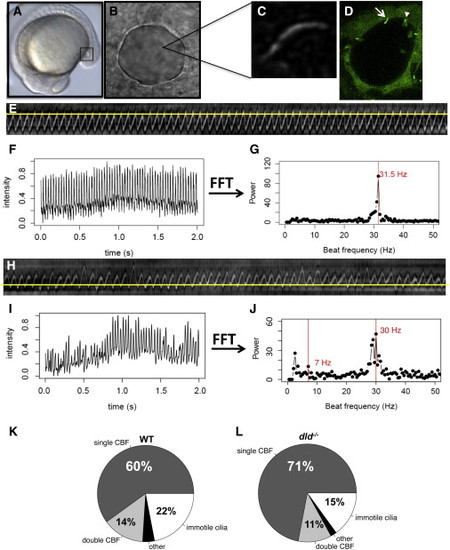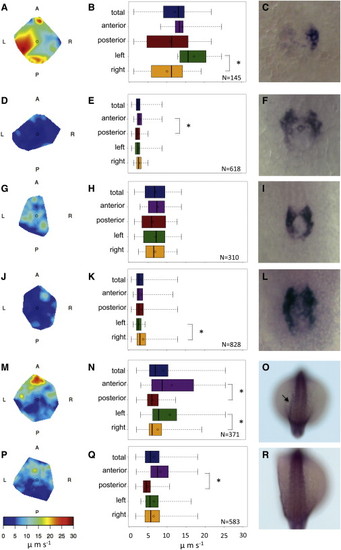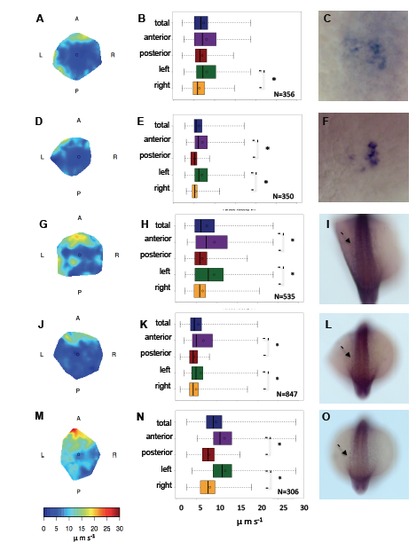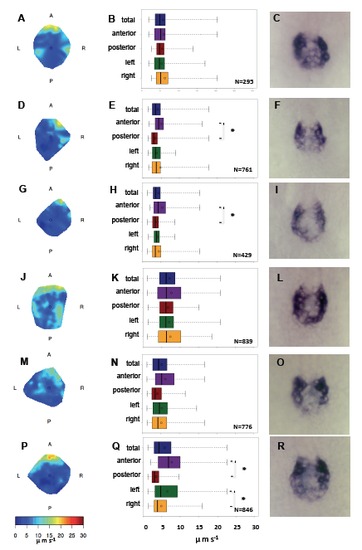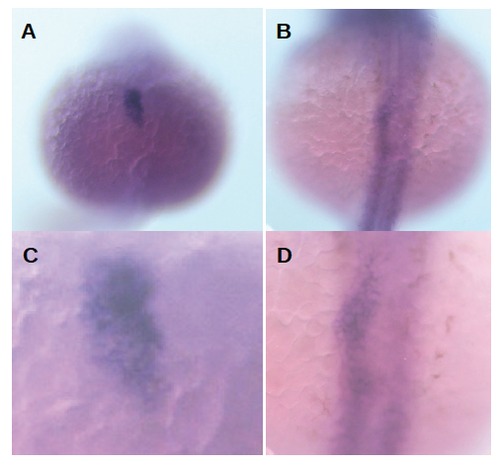- Title
-
Left-Right Organizer Flow Dynamics: How Much Cilia Activity Reliably Yields Laterality?
- Authors
- Sampaio, P., Ferreira, R.R., Guerrero, A., Pintado, P., Tavares, B., Amaro, J., Smith, A.A., Montenegro-Johnson, T., Smith, D.J., Lopes, S.S.
- Source
- Full text @ Dev. Cell
|
Genetically Generating a Range of Fluid Flow Speeds (A) Cartoon representing a Kupffer’s vesicle in 3D; light blue denotes central region, dark blue illustrates the peripheral region, and the arrow shows how we scanned the KV for native particles (represented in red) according to the dorsal-ventral axis. (B–E) Representative KV flow map (B) for a WT embryo, (C and D) for two different dld-/- mutant embryos, and (E) for a MO-dnah7-injected embryo displaying what seems to be Brownian motion (arrows). Left is to the left and anterior to the top throughout. (F) Zebrafish embryo with 14 hpf showing expression of dnah7 mRNA in the KV. (G) Expression of dnah7 mRNA in the KV amplified region. (H and I) Immunofluorescence with anti-acetylated α-tubulin to visualize the presence of KV cilia in a dnah7-MO-injected embryo that showed (H) complete absence of cilia motility during high-speed videomicroscopy and (I) a WT control embryo. (J) Kymograph showing an example of one motile cilium from a dnah7 knockdown embryo showing a consistent beat frequency over 2 s filmed with 500 fps. (K) Kymograph of a cilium from a dnah7 knockdown embryo that shows no active motility over 2 s at 500 fps. (L–N) Gut laterality at 50 hpf filmed from the ventral side after dissecting the yolk. z projection showing the liver, pancreas, and intestinal bulb of a (L) WT embryo tg(sox17:GFP)s870, (M) dld-/- mutant in the same genetic background and developmental stage showing a gut without lateralization, and (N) another dld-/- mutant showing reversed organ position. Li, liver; Pa, pancreas; IB, intestinal bulb. (O) Box plot of flow speed in WT, dld-/- embryos, and MO-dnah7-injected embryos (p < 0.05, Wilcoxon test). Left, central, and right conditions refer to liver situs. The total number of tracks (nt) and embryos (ne) followed with native particles for each condition was as follows: for WT: nt = 847, ne = 7; for dld-/- mutants with left liver: nt = 7,877, ne = 21; for dld-/- mutants with centralized guts: nt = 1,458, ne = 2; for dld-/- mutants with right liver: nt = 858, ne = 3; for dnah7 knockdown embryos with left liver: nt = 1,105, ne = 3; for dnah7 knockdown embryos with central liver: nt = 505, ne = 1; for dnah7 knockdown embryos with right liver: nt = 1,860, ne = 4; and for dnah7 mismatch control-MO: nt = 1,700, ne = 5. Notched box plots display a “notch” or narrowing of the box around the median. Box plot whiskers represent the minimum and maximum of all of the data. EXPRESSION / LABELING:
PHENOTYPE:
|
|
Characterization of the WT and dld/ KV Cilia Populations (A) Localization of the KV (squared region) in the body of the zebrafish embryo at 14 hpf. (B) Snapshot image of a KV of a live embryo filmed from the dorsal side. (C) Snapshot image of a KV beating cilium in a live embryo after image improved contrast for posterior kymograph analysis. (D) KV of a live embryo at 14 hpf, showing the KV cells labeled with the transgene sox17:GFP; cilia are also labeled with arl13b-GFP so that immotile cilia are bright and sharp (arrow), whereas motile cilia appear as cones with a blurred GFP label caused by the ciliary movement (arrowhead). (E) Kymograph of a cilium presenting one fundamental frequency. (F) Time series over 2 s for the same beating cilium. (G) Power spectrum analysis using FFT for the same cilium, showing that it has only one fundamental frequency of 31.5 Hz. (H) Kymograph of a cilium with two major frequencies, which we called a wobbling cilium. (I) Time series for the same beating cilium (2 s). (J) Power spectrum analysis using FFT for the wobbling cilium in (H), showing that it has two fundamental frequencies (highlighted in red): one at 7 Hz and another at 30 Hz (the lower frequency peak is an FFT artifact equal to the background noise). (K and L) Quantification of the different types of KV cilia according to motility and to CBF in (K) WT embryos, ne = 16, nc = 80, and in (L) dld-/- mutants; ne = 26, nc = 77. The class “other” includes all cilia that had a random beating pattern with no specific frequency peak after FFT analysis. KV Kupffer’s vesicle; CBF cilia beat frequency; ne number of embryos, nc number of cilia. EXPRESSION / LABELING:
|
|
Correlation between Fluid Flow and Early L-R Markers (A–C) WT embryo with strong left-sided flow reported by flow heat map in (A) and by the quantification of flow in each KV half in (B) showing an asymmetric charon expression on the right side of the KV in (C). (D–L) Embryos injected with dnah7-MO. (D) through (F) show embryo with very weak flow as reported by the flow heat map in (D) and the quantification of flow in each KV half in (E) showing a weak symmetric charon expression in (F). (G) through (I) show embryo with strong homogeneous flow as reported by the flow heat map in (G) and the quantification of flow in each KV half in (H) showing a strong symmetric charon expression (I). (J) through (L) show embryo with weak flow showing local elevated right-sided flow as reported by the flow heat map in (J) and the quantification of flow in each KV half in (K) showing a slight degradation of charon expression on the right side of the KV in (L). (M–O) WT embryo with strong left-sided anterior flow reported by flow heat map in (M) and by the quantification of flow in each KV half in (N) showing an asymmetric spaw expression on the left side of the LPM in (O). (P–R) WT embryo with no biased L-R flow as reported by flow heat map in (P) and by the quantification of flow in each KV half in (Q) showing absent spaw expression on the LPM in (R). N, number of particle tracks measured in each embryo. Boxplot whiskers represent the minimum and maximum of all of the data. Means are represented as small circles. p< 0.05, Wilcoxon test. EXPRESSION / LABELING:
|
|
Correlation between normal fluid flow and early left-right markers, Related to Figure 6. (A-F) Wild-type embryos with flows higher than 5 μms-1 with stronger left sided flow reported by flow heat map (A, D) and by the quantification of flow in each KV half (B, E) showing an asymmetric charon expression on the right side of the KV (C, F). (G-O) Wild-type embryos with strong left sided anterior flow reported by flow heat map (G, J, M) and by the quantification of flow in each KV half (H, K, N) showing an asymmetric spaw expression on the left side of the LPM (I, L, O). KV Kupffer’s vesicle; LPM lateral plate mesoderm; N number of particle tracks measured in each embryo. Arrows indicate spaw expression; boxplot whiskers represent the minimum and maximum of all of the data. |
|
Correlation between lower fluid flow and early left-right markers, Related to Figure 6. These embryos were injected with dnah7-MO to generate a range of weak flow scenarios. (A-C) Embryo with ~ 5 μms-1 homogeneous flow in the KV, as reported by the flow heat map (A) and the quantification of flow in each KV half (B), this embryo registered strong symmetric charon expression (C). (D-I) as reported by the flow heat maps (D, G) and the quantification of flow in each KV half (E, H), these embryos registered the lowest flows (< 5 μms-1) and show the weaker symmetric charon expression patterns (F, I). (J-R) Embryos with clearly higher than 5 μms-1 flow speeds. (J-O) These two embryos have homogeneous flow as reported by the flow heat maps (J, M) and by the quantification of flow in each KV half (K, N), and show strong clear symmetric expression of charon with embryo L slightly stronger than embryo O. (P-R) Injected embryo showing a wild-type pattern of flow as reported by the flow heat map (P) and the quantification of flow in each KV half (Q) showing a weak charon expression on the left side of the KV and strong expression on the right side (R). KV Kupffer’s vesicle; LPM lateral plate mesoderm; N number of particle tracks measured in each embryo; boxplot whiskers represent the minimum and maximum of all of the data. |
|
Earliest left-sided expression of internal organ precursors, Related to Figure 6 and Discussion. Figures A and B are amplified in C and D, respectively. The early heart marker lefty2 is asymmetrically expressed on the left lateral plate mesoderm at 18 hpf (A, C). foxa3 expression in the gut endoderm started to be asymmetric towards the left side of the midline between 22 and 24 hpf (B, D). |
Reprinted from Developmental Cell, 29(6), Sampaio, P., Ferreira, R.R., Guerrero, A., Pintado, P., Tavares, B., Amaro, J., Smith, A.A., Montenegro-Johnson, T., Smith, D.J., Lopes, S.S., Left-Right Organizer Flow Dynamics: How Much Cilia Activity Reliably Yields Laterality?, 716-28, Copyright (2014) with permission from Elsevier. Full text @ Dev. Cell

